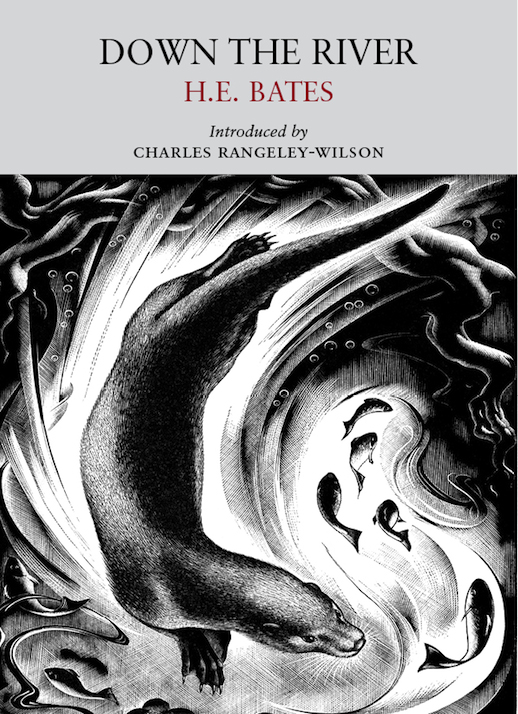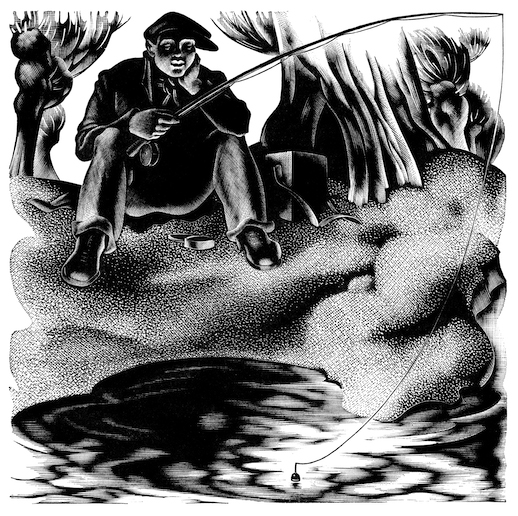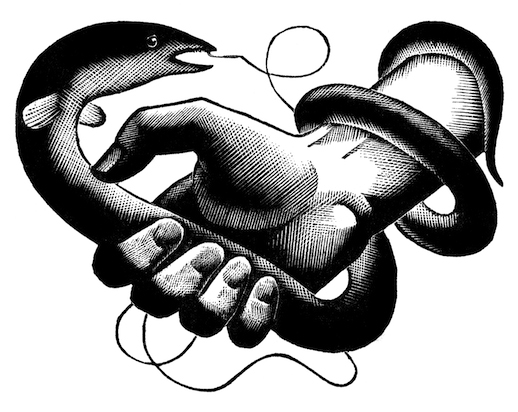H.E.Bates; Down The River
144 pages with illustrations from Agnes Miller Parkers
Introduction to this edition by Charles Rangeley-Wilson.
H.E. Bates’s Down the River is just one of many works of literature about a river or rivers. Spenser, Drayton, Wordsworth, Auden, Hughes, Maclean, Hemingway, Magris: the list of writers spellbound by rivers is a long one. Rivers lend themselves to being thought and written about. Thought flows like a river. As does language. The river, memory and the impulse to write, the sounds and rhythms of words and water, these things merge time and again across the centuries to become the poetry and prose of rivers, flowing from Babylon to Devon.
But so much fine writing is impelled not just because of a sympathy between the forms and expressions of thought and water. A river speaks, too. It has character. And a river is the most animate part of a landscape. A river gives life, quite literally and is abstractly venerated for that gift: a river is god: ‘a strong, brown god’, wrote Eliot of the Mississippi. A river is timeless. And yet a river moves like time, flowing from the past and to the future, through our temporal landscape, as well as its own physical one. As Bates writes, there is something too about water in general and rivers in particular that ‘tranquilises the soul’, that causes men to sit still and think, or do nothing. It is in these moments that art begins.
If a landscape is a body, a river is its breath: this is a metaphysical conceit, but it has literal truth too. Rain is the earth breathing in, drawing water into the soil and lungs of itself. That water gives life to the body. And then in the flow of a river the valley exhales, its breath the soil and history and character of that place, expression of the landscape it passes through. This distillation of a landscape’s story means that literature finds in the river an exact parallel of its own process, a refinement and concentration of meaning. And that is perhaps, most of all, why so many writers write about rivers.
I first read Down the River in late 2002, the year Alice Oswald published Dart, ‘a huge poem about the River Dart, using the voices of all the people who live and work alongside it’, as she described her project. Oswald recorded conversations with walkers and fishermen, farmers, stone-wallers, harbour-masters and sewage-workers, with swimmers and prisoners; she used those recordings as life-models ‘linking their voices into a sound-map of the river, a song-line from the source to the sea.’ The poem flows from one voice to the next, the river speaking too, asking questions, remembering. Sometimes the words are lyrical and abstract, other times anchored and concrete. The poem was an awakening for me of the possibilities of writing about the natural world and the people who shape it and are shaped by it. In the fervour of research that followed my discovery of Dart I meandered my way to Bates’s book and found a similar tapestry in prose, a weave of human and natural history and an evocation of the landscape out of which they grew. I have read it – and Dart – three or four times now, at least.
Although Down the River is a work of non-fiction prose, lightly dusted with an icing of the romantic pastoral, and while Dart is a poem whose language and sentiment is formed from the bog and bones of the moor and from the working language of its people, the two works have much in common in subject, ambition and structure. Because the river is a living poem, living prose, it shouldn’t be surprising that two writers of different temperaments, different times, should resonate and reflect beneath the surface of style and the geology of form.
Nor should have been my discovery – although I was amazed and delighted when I found it – of a passage written by Samuel Taylor Coleridge in 1797 in which he described his ambitions for a poem that he intended to call ‘The Brook’. His words from Biographia Literaria, written over two hundred years ago, are a startling trailer for Down the River and then Dart.
“I sought for a subject that should give equal room and freedom for description, incident, and impassioned reflections on men, nature, and society, yet supply in itself a natural connection to the parts, and unity to the whole. Such a subject I conceived myself to have found in a stream, traced from its source in the hills among the yellow-red moss and conical glass-shaped tufts of Bent, to the first break or fall, where its drops became audible, and it begins to form a channel; thence to the peat and turf barn, itself built of the same dark squares as it sheltered; to the sheep-fold; to the first cultivated plot of ground; to the lonely cottage and its bleak garden won from the heath; to the hamlet, the villages, the market-town, the manufactories, and the sea-port. My walks therefore were almost daily on the top of Quantock, and among its sloping coombs. With my pencil and memorandum book in my hand, I was making studies, as the artists call them, and often moulding my thoughts into verse, with the objects and imagery immediately before my senses. Many circumstances, evil and good, intervened to prevent the completion of the poem, which was to have been entitled ‘The Brook’.”
Sadly, only a fragment of this never-realised work exists, and it was Oswald who finished Coleridge’s job of moulding thoughts to rivery verse many years later, though she went west from the Quantocks to Dartmoor to do it. But there is much poetry in Down the River too. As a work of literature it stands firmly in the stream that links Coleridge to Oswald. And in writing about the rivers Nene and Ouse, Bates chose more fertile ground for his work, certainly in terms of a landscape that would yield ‘impassioned reflections on men, nature and society’, whose rivers supplied the ‘natural connection’ of the parts and a unity to the whole. Few rivers have been as well used by men as these twin giants of the Midlands.
The best of a country’s history, writes Bates, is in its rivers. Mills and millers, barges and barge-men, laceworkers, pig-farmers, anglers, and ice-skaters, the stonily independent people of the Nene, the tatty, pseudo-genteel of the Ouse, all are born on the waters of these rivers and are, in Bates’s eyes, wet with their nurturing. So was Bates. People and rivers share birth, though a river’s is never-ending, and thus rivers are a paradox of ‘eternal age and eternal youth’. But Bates tells us in the very first line that he was born within sight of a river and counts it the luckiest thing in his life. That river was the Nene, ‘not merely a river’ but a history, while the Ouse, just over the hill, was ‘idyllic and generous’.
Together the two were like breasts ‘which suckled me’ while ‘in memory they still nourish me’. For Bates, as for the Romantic poets, the river is a life-giver, a muse and a lifelong source of healing and comfort. And like those poets he is drawn ‘like a magnet’ to the river’s source, the spring of the wet-nurse stream. The Nene takes its name from nine of them, though one in particular sticks in Bates’s memory: ‘that spring gushing out from under the raw elbow roots of cow-smoothed hawthorns, still remains for me not only the source of the Nene, but the source of all rivers.’ I doubt the word ‘gushing’ has often been used to better effect. You can almost hear the water, almost smell the tang of clay, and cows and hawthorn flowers in spring.
It is difficult to say where Bates is at his best, as he describes the people, the histories, the wildlife or the landscapes of the Nene and Ouse. But rarely, in fact, does he write about one to exclusion of the others: the ‘natural connection’ of the parts is so much at the heart of this book. Bates writes of the lacemaking tradition brought to the Nene and Ouse by exiled lowland Protestants and French Huguenots: ‘It is odd to think of these two rivers, so like threads of water themselves, being bound together for hundreds of years by threads which were almost as miraculous and delicate as water itself’. Time and again through Down the River the landscape and its history stand as metaphors for each other, the effect as arresting as it is revealing. The country mill, for example, ‘occupies on the river something of the position of inns and churches on the road, and it makes, with them, that staunch triangle of religion and malt and corn on which so much of the history of these islands has been built.’
For Bates the river is the whole of life: ‘The Nene’ he writes, ‘reflects all of that jumbled complexity of character as though it were a mirror held and tilted through centuries by time and circumstance. It has all the characteristics of the country through which it flows, its valleys are pasture, its bridges stone; it has in certain places a drabness, almost a meanness, exactly like that of the towns it flows past, as though time had washed the muck of them down to it.’
That is exactly what time has done of course, and Bates captures these nuances of character and the inseparability of landscape, people and history so well. The Ouse plays second fiddle in this book, which is really a love song to its more phlegmatic northern twin, but in setting the two together – and apart – Bates’s observations and descriptions are superb. The Nene is ‘straight and bony, utilitarian, unfrilled’. Its towns and their bleak hill-top locations reflect the ‘use before prettiness’ outlook of its people. Not so the ‘soft, indecisive’ Ouse, a ‘broad bosom of a stream’ whose waterside villages have names exactly appropriate to the ‘soft-spoken and soft-thinking’ people who built them.
Though he loves the flowers, wildlife and luxuriance of the river, Bates hasn’t much time for Ouse folk, whose pretensions he dislikes. He sees, enacted in the histories of these two rivers, a sort of cameo of English class warfare, of servitude, squirearchy and revolution. The people of the Ouse remain bound by cap-doffing obeisance and mincing petty-snobbery, while the revolutionaries of the Nene at least have dignity in their poverty. It’s a little two-dimensional. The meditation culminates in one of the best passages in the book, though Bates comes off the worst. . . He is shown around a house which he is thinking of buying by a deaf and wiry old aesthete, the sort of nouveau pauvre eccentric that a certain part of Middle England is built from, who has crammed the place with a lifetime’s worth of faded, genteel paraphernalia, with ‘the clumsy jumbled relics of the days when she must have been a somebody, one of the Miss Somebodies, young and eligible, with chances and perhaps a look in her eye, and full hips, and some shape in her now ironed-out breasts.’ But as Bates tours the house, exasperated by her deafness – which he suspects is feigned – hating her affectations, as he skewers the flaws and tics of her personality, the batty old spinster becomes more and more appealing, as much as Bates tries to make us dislike her. ‘Trying to build up about herself the ramparts of superfine gentility,’ he concludes, ‘she has preserved and cherished every stitch and page and nail of things even faintly aristocratic, quite blind to the muck and jumble and craziness of it all, seeing only the ideal, worshipping only the silly godhead of a decaying but elegant world.’ His observations are fabulous but you get the impression that a different artist in a different age would be less contemptuous of the ‘stupid and sinister’ jumble of genteel filth and its hermaphrodite curator. It is the one place Bates – too keen to make us think something – trips himself up into telling when the showing is already so good. Even so the slip gives us a glimpse of Bates the person, downwind of two sherries as it were, betraying his own petty prejudices. Did he make an offer on the house and was it spurned? One can’t help but wonder quite what the mad old girl did or what she represented to deserve the onslaught.
Elsewhere Bates only shows, and he shows brilliantly. Though there is a varnish of elegiac romanticism, and here and there a flashy authorial flourish, Bates’s prose is for the most part solid and anchored and evocative. He sees with a fresh eye and describes with fresh words: a rare trick in writing, and rarer still in writing about the natural world. Virginia Woolf in praising another river writer, J.W. Hills, said that the neatest trick of all was laying your idea or scene or description in the mind of the reader ‘like an egg’ from which might hatch the thing itself. If that is so then Down the River pulls off the neatest trick time and again, a cascade of vivid, three-dimensional images, of the river ‘running like a snake through illimitable green acres’, of the ‘rain deluging down on a world of sepulchral blackness’, of the ‘quiet breadth of water and its weed-grown darkness’, of ‘cloudy willows, nothing but trees of smoke’, of the kingfisher’s ‘flight of blue electricity’, of great pike ‘the mere silky shadow of a great leaf drowning dimly in the sun-clear water’.
While the odd phrase suggests Down the River was a work of recollection more than it was a field study or that some of the time Bates was winging it – he refers to schools of trout, men shooting birds with bullets, the English peacock having ‘something of the Oriental’ about it, and a ‘hovering’ sparrowhawk – most of the time you wouldn’t know that Bates isn’t right there, his easel in front of the world, setting down what it was like at that very moment. The best of this is where he is most authoritative and that is the stuff drawn from his own experience as a boy: the chapters on flooding and frost are as rooted in the floodplain as the willows Bates so memorably describes: ‘that still taut world of profound coldness’ he writes of the time each winter when the ice arrived, ‘with its sugar frost and sugar trees and sedges, the beautiful loftiness of the pale-blue wintry sky, the almost red winter sun falling very early across the meadows in the afternoons towards a horizon already smoky and tawny with the promise of frost’. This is recollection of the best kind, it is ‘emotion recollected in tranquility’.
Bates, however, was above all a novelist, with a gift for narrative movement, for character and dialogue. Once in a while he lets these skills off the leash and – without taking anything away from the other parts of the book – these are the highlights. There is a passage that begins about half-way through the third chapter and continues for twenty or more pages, across at least one chapter break. It is a seamless stroll through boyhood memories of a grandfather, pig-rearing and fishing, among other things, conducted as an actual Sunday stroll from the back door along River Lane towards the Nene. It is fabulous.
‘Men, nature and society’ – in metaphor, meditation, and observation, and in dialogue as real as the folk who spoke it, all these things come together in the dense tapestry of water and man that is Down the River, a worthy incarnation in prose of Coleridge’s unfulfilled poetic aspiration.
Down The River is published by Little Toller, and is out now. Copies can be bought from the Caught by the River shop, priced £10.
Silt Road: The Story of a Lost River, by Charles Rangeley Wilson, is out now in papaerback.


